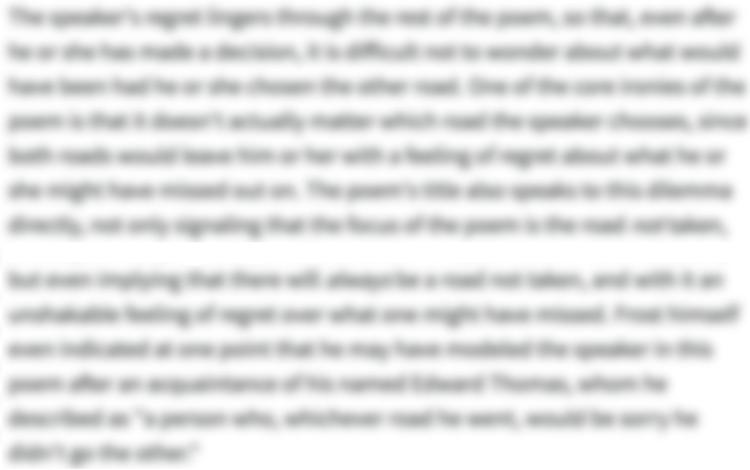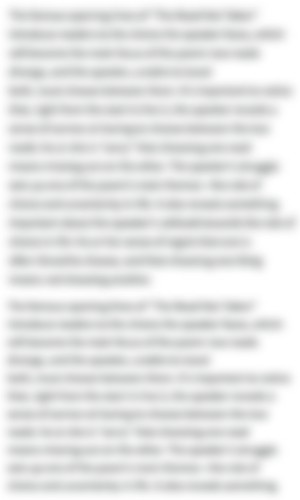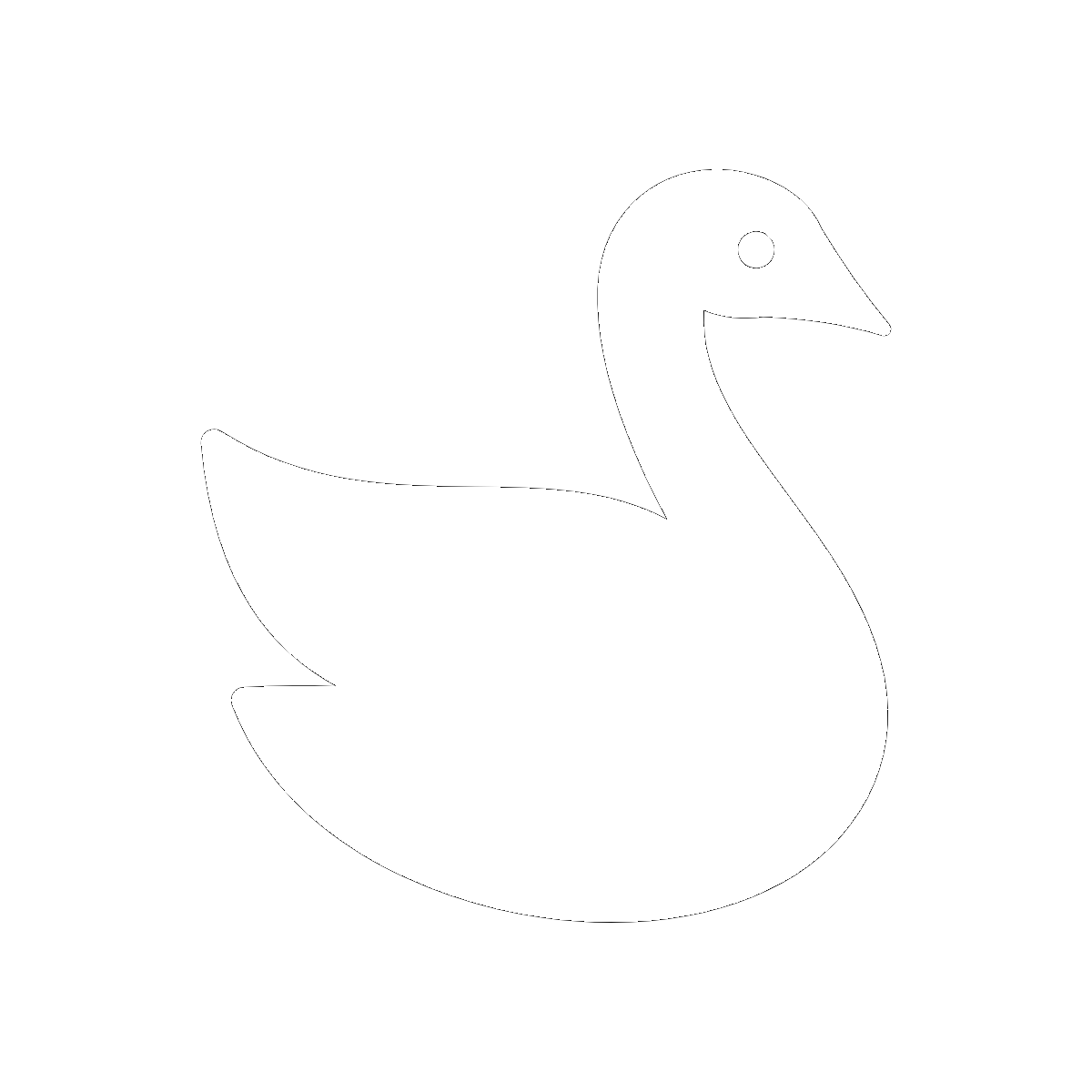The Full Text of “The Wild Swans at Coole”
1The trees are in their autumn beauty,
2The woodland paths are dry,
3Under the October twilight the water
4Mirrors a still sky;
5Upon the brimming water among the stones
6Are nine-and-fifty swans.
7The nineteenth autumn has come upon me
8Since I first made my count;
9I saw, before I had well finished,
10All suddenly mount
11And scatter wheeling in great broken rings
12Upon their clamorous wings.
13I have looked upon those brilliant creatures,
14And now my heart is sore.
15All's changed since I, hearing at twilight,
16The first time on this shore,
17The bell-beat of their wings above my head,
18Trod with a lighter tread.
19Unwearied still, lover by lover,
20They paddle in the cold
21Companionable streams or climb the air;
22Their hearts have not grown old;
23Passion or conquest, wander where they will,
24Attend upon them still.
25But now they drift on the still water,
26Mysterious, beautiful;
27Among what rushes will they build,
28By what lake's edge or pool
29Delight men's eyes when I awake some day
30To find they have flown away?
-
“The Wild Swans at Coole” Introduction
-
"The Wild Swans at Coole" is a poem by W.B. Yeats, published in a collection of the same name in 1917. Written when Yeats was in his 50s, the poem sees a speaker visiting Coole Park in Ireland (a place which Yeats himself had visited). Here, he observes a large group of swans, comparing the present moment to his first visit to the park 19 years prior. Though the speaker admires the swans, the whole poem is suffused with an atmosphere of melancholy and regret—with the speaker projecting the kind of traits onto the swans that he feels he now lacks. There has been much speculation about the source of the speaker's feelings. The poem itself subtly alludes to lost love, and many critics also point to the timing of the poem's composition—shortly before the end of World War I, during the Irish struggle for independence from the British—as being highly significant.
-
-
“The Wild Swans at Coole” Summary
-
The trees are filled with fall colors, and the paths through the woods are dry. It's an October evening and the Coole lake reflects the calm, motionless sky above. I can see fifty-nine swans swimming in the lake, which is almost overflowing with water.
It was nineteen years ago that I was first here and counted the swans. Back then, before I could count them all, the birds suddenly flew up above me in huge broken circles, soaring around on their noisy wings.
Looking at these beautiful birds now, I feel heartache. Everything has changed since I first stood on the shore of the lake at twilight and heard the swans' wings beating like bells above my head. Back then, I used to walk with a lighter step.
The swans are still just as full of life as they were back then. In their loving pairs, they paddle through the cold, friendly water or soar into the sky. Their hearts remain young. Their lives are still filled with passionate desires, with the freedom to go wherever they want.
At this moment, though, the swans float on the calm surface of the lake, distant and beautiful. In the future, where will they build their nests? Where will other men have the pleasure of seeing the swans, when I wake up one day to find that they've flown away from Coole?
-
-
“The Wild Swans at Coole” Themes
-
Time and Aging
“The Wild Swans at Coole” is a bleak, mournful poem, in which the speaker returns to a lake in Ireland (the “Coole” of the title) that he first visited 19 years earlier. Here, he observes a group of swans, just as he had years before. But instead of bringing him joy, the swans’ beauty and vitality now fill the speaker with a bittersweet feeling. This is because the “unwearied” swans seem to have stayed the same—still filled with passion, mystery, and brilliance—while the speaker’s own life has been changed irreversibly by the onward passage of time. In other words, the swans remind the speaker that he himself has grown older and drifted further from the vibrancy and possibility of his youth. With aging, the poem thus suggests, comes a tangible sense of loss for all the life left behind.
The poem is essentially a tale of two moments: the memory of the speaker’s first visit to Coole, and the present-day in which he finds himself there again (though it’s not clear if has visited in between those two moments). Through comparing these moments, the poem is able to explore the way that the relentless passage of time has affected the speaker, diminishing his lust for life and making him weary.
The poem begins by signaling that the speaker feels himself to be in the “autumn” of his life. The general setting establishes a sense of transition, one which echoes the way that the speaker feels that, ultimately, his hopes and dreams—later phrased as “passion or conquest”—have passed him by.
Looking at the numerous elegant swans on the lake, the speaker starts to draw a distinction between the time when he first saw them (19 autumns ago) and the present moment. He clearly admires the swans, calling them “brilliant.” But “[a]ll’s changed” since he first stood on the shore at Coole. The swans’ brilliance is a kind of constant—true then and true now—which contrasts with the way that the speaker feels himself to have changed over the years. Back then, the speaker walked with “a lighter tread”; now his age and life experiences make him metaphorically heavier and slower. This, of course, juxtaposes with the ever-present grace of the swans, which, again, appears the same now to the speaker as it was back then.
To that end, the swans’ way of being reminds the speaker of how he himself used to be. This is drawn out by the way the poem describes the differences between the swans and the speaker in the present day, implying that he used to have more of the traits he continues to perceives in the birds. Whereas the swans are “Unwearied still,” and “their hearts have not grown cold,” the speaker can no longer say the same of himself. The poem implies that he has grown weary, and his heart has grown cold.
It’s not specified what exactly has happened in the nearly two decades since the speaker first visited Coole. From the mention of “lover[s]” and “hearts,” the reader can presume that, in part, the speaker mourns for lost love. But critics also speculate that, given the timing of the poem’s writing, the loss that the speaker feels extends more widely: the poem was written soon after the horrors of the First World War and during the continuing struggle for Irish independence from the British.
That said, the specifics are not really the main point here. What’s important is the way that the speaker senses these changes to be irreversible: time can only travel in one direction, and the good times—like the speaker’s first visit to Coole—are only memories. In other words, there’s no going back. That’s why the swans seem to evoke such bittersweet feelings for the speaker. There is something timeless, magisterial even, about their way of being. They also seem free to “wander where they will,” and remain “mysterious, beautiful.” They remind the speaker of what he has lost to time.
“The Wild Swans at Coole,” then, shows an individual struggling to come to terms with the path that life has taken. Ultimately, this speaks to the way that life runs an irreversible course—people can’t go back or change the way that things have turned out. The speaker holds on to happier memories, but these are tinged by the sadness that they are fated never to become real experiences again.
- See where this theme is active in the poem.
-
Nature vs. Humanity
Nature in the poem is presented as something that is unchanging in its beauty and majesty. This creates a sense of division between the world of nature and that of human beings, which, as represented by the speaker, is acutely aware of the passage of time and plagued by a sense of loss. Nature also seems untroubled by—perhaps even entirely indifferent to—human foibles, the swans continuing to appear full of passion and vigor even as the speaker is weighed down by the hopes, dreams, and disappointments that people experience in life. This doubles down on the poem’s gentle sense of isolation and sadness about aging, heartbreak, and perhaps even wider contextual issues like the First World War. These issues, the poem subtly suggests, remain small or insignificant in the face of nature's everlasting grandeur.
Throughout the poem, the speaker projects human thoughts and feelings onto the swans. However, this serves to highlight that this is a one-way relationship—the swans, and nature more generally, go on as they are without any need for the speaker's awe or observations. This hints at the complexity of human life, contrasted with what seems like the more instinctive existence of the swans. Nature is clearly not under the speaker's control; when he first tried to count the swans—a kind of application of human logic and rigor to nature—they soared into the sky "before [he] had well finished." The swans, of course, didn't for him to finish counting, but just did whatever came instinctively to them.
Nevertheless, as the poem goes on, the speaker projects his whole world of human feelings and emotions onto the swans. He characterizes them as “lover[s]” with “hearts” that are set on “passion or conquest” as they please. But the sense of distance between the speaker and the swans remains palpable. That is to say, the swans are just going about their lives in accordance with their nature. They don’t seem to doubt themselves or worry about their place in the world—they just inhabit their environment. There's thus something almost comical—and tragic—about the speaker's attempt to view nature through the prism of his own feelings. That said, it's also something that everybody does, and so indicates something fundamental about the human condition: the need for understanding, sympathy, and narrative within the broader world.
Indeed, the speaker wonders in the poem’s closing lines if the swans might “some day” have “flown away.” It’s perfectly possible, of course, that—in accordance with their nature—the swans might do this. This heightens the sense of distance between the speaker and the swans, thereby also intensifying this sense of fundamental difference between humanity and nature itself. Furthermore, this makes the speaker's life seem small and insignificant. That is, the unchanging—and majestic—nature of the swans is a kind of stand-in for the way in which his own life has had little effect on the world. And while he might have wanted his life to make a difference in the past, now he feels too weary to believe that to be possible anymore.
- See where this theme is active in the poem.
-
-
Line-by-Line Explanation & Analysis of “The Wild Swans at Coole”
-
Lines 1-4
The trees are in their autumn beauty,
The woodland paths are dry,
Under the October twilight the water
Mirrors a still sky;The poem opens with four lines of scene setting. The speaker, not yet using the first-person pronoun, gives an account of the Coole surroundings (Coole is located in Ireland's County Galway). The leaves on the trees have begun to change colors, the paths dry, and twilight casts its dim glow upon the water. There is a sense that the season is on the turn: summer has turned to autumn, which in turn will lead to winter. This hints at the speaker's attitude later in the poem—he is in the autumn of his life, anxious that his best days are behind him.
On a similar note, the "still[ness] of the sky in line 4 pre-empts the way that the speaker's life has reached a kind of stasis, and that the more actively engaged days of his earlier years are gone. Likewise, the use of "Mirrors" in this line suggests that this poem is a kind of psychological reflection, a reckoning in which the speaker comes to terms with—or attempts to come to terms with—where his life is at. Consonance is at play through all four lines, with gentle /t/ and /d/ sounds conveying the delicate beauty of the autumnal scene:
The trees are in their autumn beauty,
The woodland paths are dry,
Under the October twilight the water
Mirrors a still sky;The alliteration of "still sky" also contributes to the scene setting: the line seems to linger on this /s/ sound, evoking the stillness of the Coole surroundings.
-
Lines 5-8
Upon the brimming water among the stones
Are nine-and-fifty swans.
The nineteenth autumn has come upon me
Since I first made my count;

Unlock all 318 words of this analysis of Lines 5-8 of “The Wild Swans at Coole,” and get the Line-by-Line Analysis for every poem we cover.
Plus so much more...
Get LitCharts A+ -
Lines 9-12
I saw, before I had well finished,
All suddenly mount
And scatter wheeling in great broken rings
Upon their clamorous wings. -
Lines 13-18
I have looked upon those brilliant creatures,
And now my heart is sore.
All's changed since I, hearing at twilight,
The first time on this shore,
The bell-beat of their wings above my head,
Trod with a lighter tread. -
Lines 19-24
Unwearied still, lover by lover,
They paddle in the cold
Companionable streams or climb the air;
Their hearts have not grown old;
Passion or conquest, wander where they will,
Attend upon them still. -
Lines 25-30
But now they drift on the still water,
Mysterious, beautiful;
Among what rushes will they build,
By what lake's edge or pool
Delight men's eyes when I awake some day
To find they have flown away?
-
-
“The Wild Swans at Coole” Symbols
-
The Swans
The swans are representative of the majesty and power of nature. They are beautiful creatures that move gracefully, but they are also strong and powerful. Their wings are "clamorous"—or noisy—but also like the beating of bells, evoking a sense of awe and wonder from the speaker. They act according to instinct and will, and as such also, for the speaker, represent a kind of freedom from human anxieties and logic. Note how, on his first visit, the speaker wanted to count how many swans were on the lake but they suddenly flew away before he could finish—demonstrating both their unpredictable power and the fact that they are detached from the speaker's control. In a way, then, the swans represent not just the majesty of nature but also its indifference to humanity's conflicts and struggles—which, in turn, seem all the more insignificant in the face of nature's everlasting grandeur.
Indeed, the speaker uses the swans as a kind of symbol for constancy as he takes stock of his life. While sensing himself to have changed beyond recognition, the swans remain filled with passion and vitality. They don't seem to have changed at all since his first visit, which only serves to make the speaker melancholic. The much-repeated fact about swans mating for life plays on his mind, as he perceives them as "unwearied" "lover[s]." Furthermore, their "hearts have not grown old." By implication, the speaker is wearied, and his heart has "grown old." They function above all, then, as a kind of mirror that the speaker holds up to his own life.
- See where this symbol appears in the poem.
-
-
“The Wild Swans at Coole” Poetic Devices & Figurative Language
-
Alliteration
Alliteration is used sparingly in "The Wild Swans at Coole," but to great effect. Line 4, for example, alliterates in the phrase "still sky." The focus on this hushed /s/ sound momentarily quiets the poem, matching with the phrase's idea of calm stillness.
The next important example doesn't come until just over halfway in the poem—in fact, two examples come close together:
The bell-beat of their wings above my head,
Trod with a lighter tread."Bell-beat" describes the effect of the swans' wings on the air as they flew over the speaker during his first visit to Coole. The alliterative /b/ sounds have a muscular rhythmic quality, mimicking the strength and sound of the birds' wings. Shortly after, as if subconsciously wanting to imitate the swans, the speaker alliterates in a description about himself. The play of "Trod" with "tread" has a nursery-rhyme or riddle-like sound, convey the way that the speaker used to walk more lightly. On his first visit to Coole, he was more optimistic about life, and, of course, younger. Now he feels the heaviness of his steps.
The next meaningful example comes in line 19. In this stanza, the speaker strongly personifies the swans:
Unwearied still, lover by lover,
They paddle in the cold
Companionable streams or climb the air;The repeat of "lover" here—which is also diacope—has an almost luxurious sound, hinting at the pleasures and joys of being in love (which the speaker seems to mourn for). Note that this effect from the /l/ sound is further boosted by consonance in these lines ("paddle," "cold," "companionable," and "climb"). The repeated hard /k/ sound again focuses readers' attention on the swans' actions.
Line 23 also uses alliteration effectively:
Passion or conquest, wander where they will,
The three /w/ sounds seem to do their own wandering through the line, evoking the swans' freedom and grace of movement.
- See where this poetic device appears in the poem.
-
Caesura


Unlock all 232 words of this analysis of Caesura in “The Wild Swans at Coole,” and get the poetic device analyses for every poem we cover.
Plus so much more...
Get LitCharts A+ -
Consonance
-
Diacope
-
Enjambment
-
Pathetic Fallacy
-
Personification
-
Rhetorical Question
-
Assonance
-
-
“The Wild Swans at Coole” Vocabulary
Select any word below to get its definition in the context of the poem. The words are listed in the order in which they appear in the poem.
- Twilight
- Brimming water
- Nine-and-fifty
- Wheeling
- Clamorous
- Bell-beat
- Trod / Tread
- Unwearied
- Companionable
- Attend
- Rushes
Twilight-
The period just before total darkness in the evening. "Twilight" is also often used metaphorically to refer to the later years of a person's life.
- See where this vocabulary word appears in the poem.
-
Form, Meter, & Rhyme Scheme of “The Wild Swans at Coole”
-
Form
"The Wild Swans at Coole" consists of five sestets (six-line stanzas). Though each stanza includes the same number of lines, variations in meter and line length keep the poem interesting and unexpected.
Swans are elegant—and powerful—creatures, and the poem's subtle but strong movement from start to finish gently quietly represents this. But the poem's form also allows it to maintain an air of doubt and uncertainty, as though it is searching for its final form and may never find it. This, of course, represents the other key presence in the poem: the speaker himself. His mindset is somewhat meandering, his words describing a general sense of loss without the ability—or perhaps willingness—to pinpoint its exact source.
In terms of the way the poem unfolds, the first stanza sets the scene and anticipates the speaker's mood—the dry woodland paths, autumn leaves, and twilight setting all suggestive of time passing and something coming to an end. The second and third stanzas deal primarily with the speaker's memory of his first visit to Coole, while the fourth stanza can be fairly described as the personification stanza—the height of the speaker's projection of human feelings and emotions onto the swans. The final stanza then takes a doubtful look into the future, with the speaker wondering where the swans might build their nests in Autumns to come.
-
Meter
The best way to describe the meter in "The Wild Swans at Coole" is controlled but varied. The poem is generally governed by iambs, metrical feet which follow an unstressed-stressed (da DUM) rhythm. This might give the poem a sense of weary, plodding momentum, which is in keeping with the contemplative mood.
But the poem's lines vary greatly in terms of the number of metrical feet per line. The shortest are trimeter—three-foot lines—and the longest are pentameter (five). Generally speaking, each sestet follows a pattern in terms of the amount of stresses in each line, but as is clear from below, there are many variations throughout:
- Tetrameter or pentameter - four or five feet ("The trees | are in | their au- | tumn beauty")
- Trimeter - three feet ("The wood- | land paths | are dry")
- Tetrameter or pentameter - four or five feet ("Under | the Oct- | ober | twilight | the water")
- Trimeter - three feet ("The first | time on | this shore")
- Pentameter - five feet ("Upon | the brim- | ming wa- | ter a- | mong the | stones")
- Trimeter - three feet ("Are nine- | and-fif- | ty swans")
As is clear above, many lines often incorporate an extra syllable at the end, giving them lines a lilting, almost mournful quality. The first line is a good example:
The trees | are in | their au- | tumn beauty,
In fact, this extra syllable appears in the first line of almost every stanza. Take the fifth:
But now | they drift | on the | still water,
This extra syllable at the end gives the line a falling sound, momentarily undermining the usual reliable sound of iambs.
The overall effect of the complexity described above is that, on one level, the poem refuses to settle. This subtly conveys both the tired but restless mind of the speaker and the unpredictable movement of the swans.
-
Rhyme Scheme
Each stanza of "The Wild Swans at Coole" follows the same rhyme scheme:
ABCBDD
The overall effect of these steady, yet not overwhelming, rhymes is to create a sense of graceful movement throughout the poem. This mirrors the movements of the swans, which are powerful yet beautiful in the way that they navigate the world. Apart from the first stanza, the couplets at the end of each sestet chime together neatly. The first pair, in lines 5 and 6, is not quite a perfect rhyme: stones/swans is instead a slant rhyme. This gently suggests the swans' independence from the speaker, the way that they are not beholden to the human world and form.
-
-
“The Wild Swans at Coole” Speaker
-
"The Wild Swans at Coole" is written from a first-person perspective, though the introduction of the "I" is delayed until line 8 (in the second stanza). The speaker is implied to be an older man, perhaps someone in the "autumn" of his life. It's clear, too, that the speaker of the poem is not in a very optimistic place. He feels the weight of years on his back as he revisits a spot he first came to 19 years prior, and seeing the seemingly everlasting beauty and freedom of the swans causes him to reflect on his own mortality. His "heart is sore," indicating the pain of heartbreak (from a past love or perhaps from the way his life has turned out in general). He projects human emotion onto the swans, saying more about himself than the birds (this is true in the fourth stanza especially).
There has been much speculation about the source of the speaker's melancholy, with some critics pointing to the timing of the poem's composition. It was written not long before the end of the First World War, and during the ongoing struggle for Irish independence (which Yeats was involved in). But part of the poem's power is in the way it captures a general feeling without becoming too specific.
Do note as well that the gender of the speaker is not specified in the poem. This guide has opted to use "he" for two reasons. Firstly, it eliminates too much confusion from repeated use of "they" in reference to both the speaker and the swans. Secondly, this poem is often interpreted as an autobiographical one on Yeats's part. He certainly visited Coole, and much of the sentiment in the poem is in keeping with his written thoughts elsewhere.
-
-
“The Wild Swans at Coole” Setting
-
Setting plays an important role in "The Wild Swans at Coole." As the title suggests, the setting is Coole, an area of natural beauty in Ireland. The season is unmistakably autumn and evokes a sense of winding down, or of something coming to an end. The woods are "dry," the leaves are beginning to change color and fall, and it is "twilight"—not yet night, but getting close. The setting clearly reflects the speaker's situation—he is implied to be in the "autumn" of his own life.
It's also important that this a setting being revisited. The speaker has been here before at least once (and perhaps more times). The place itself, then, functions as a kind of marker of time, with the environment and the swans appearing to be pretty much the same to the speaker as when he first visited 19 years prior. Accordingly, this puts him in a reflective and contemplative mood. Indeed, it is the way in which he senses himself to have changed—while Coole remains the same—that provokes the speaker's air of melancholy and resignation.
-
-
Literary and Historical Context of “The Wild Swans at Coole”
Literary Context
Along with Seamus Heaney, William Butler Yeats is one of Ireland's most prominent poets. He was born in 1865 and began writing around the age of 17. Yeats's influences were wide and diverse, including the English Romantics—figures such as Wordsworth ("I Wandered Lonely as a Cloud"), Blake ("London"), and Keats ("To Autumn")—and the French Symbolists, such as Stephen Mallarmé and Arthur Rimbaud. Irish mythology and folklore were also especially formative of his work, particularly given his desire for Ireland's political independence from England.
This poem appeared in Yeats' 1917 collection of the same name. It is a mournful, reflective poem, which many critics take to be written in the voice of Yeats himself. Indeed, Yeats did visit Coole, where he stayed with his friend Lady Gregory, an Irish theater practitioner. The speaker is in a contemplative mood, but the poem doesn't specify why. Certainly, aging and heartache seem to be in the poem's atmosphere—but critics also note the timing of the composition: written shortly before the end of the First World War and during the Irish struggle for independence from the British, it's possible that these subjects inform the poem too.
The poem itself is non-specific about its historical setting, but it was written during what came to be known as Yeats's middle period. The poems from this time tend to be more direct, with less reliance on symbolism and a more active—and frustrated—engagement with his more consistent subjects, like Ireland and love.
Historical Context
The year 1917, by all accounts, was a weary one for humanity. The First World War had not yet ended, and the influence of that conflict is seen in other poems by Yeats such as "The Second Coming." WWI resulted in millions of human casualties, while techniques like trench warfare devastated the land on which battles were fought. Given the extent of the war's destruction, the swans' seeming indifference to the speaker's heartache in the poem feels all the more powerful; it's as though nature doesn't concern itself with even humanity's most epic conflicts.
This poem doesn't specify a point in history, but it is certainly situated in a specific place. Set in Coole, an area in Ireland's Country Galway, it's hard not to read Yeats's passion for Irish independence into the poem too—even if it isn't mentioned specifically.
-
More “The Wild Swans at Coole” Resources
-
External Resources
-
The Poem Out Loud — A reading of the poem on YouTube.
-
Yeats In His Own Voice — A recording of Yeats reading some of his most famous poems.
-
Yeats and the Supernatural — A clip discussing Yeats, faeries, and Irish occult tradition.
-
Yeats and Irish Politics — A clip from a BBC Radio show that looks at Yeats's relationship to his home country.
-
"No Country for Old Men" — This documentary takes an insightful look at Yeats's life and work. Its title—which you may recognize from the Oscar-winning film of the same name—comes from Yeats's poem "Sailing to Byzantium."
-
-
LitCharts on Other Poems by William Butler Yeats
-











